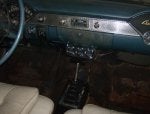I need some help wiring in the guage.I can't figure out where to hook the wires.I have a 1955 210 with a small block and an alt conversion done already.I also have the original voltage regulator on the core support which has the main wire from the alt on it.Any help would be greatly appreciated.Thanks

1955 ammeter wiring
glassguy9
1 - 8 of 8 Posts
I need some help wiring in the guage.I can't figure out where to hook the wires.I have a 1955 210 with a small block and an alt conversion done already.I also have the original voltage regulator on the core support which has the main wire from the alt on it.Any help would be greatly appreciated.Thanks
GlassGuy....Most guys don't use an ammeter anymore, because it routes the main power coming off the alternator inside the car....Too many amps and a connection failure kills everything...A voltmeter now a days is the gauge of choice....It will tell you everything you need to know...On a voltmeter, the neg side goes to a good ground source and the positive goes to a source that is hot, when the ignition is on....The top of the resistor block (brown wire) is one source for the pos. side of the gauge to connect to.
Joined
·
68,219 Posts
check out eckler's. they have install info with their gauges :anim_25:
Joined
·
31,657 Posts
I will also discourage the use of an ampmeter, especially since your not completely original and looking for all the original features that you could get on a original car.
What size is the alternator and what amperage is the meter? A large alternator can over load an ampmeter.
What size is the alternator and what amperage is the meter? A large alternator can over load an ampmeter.
I also would discourage you from installing an ammeter, especially the kind that routes full power through the gauge. Factory cars have been using voltmeters for 30 years or so now for this reason (and before that few had ammeters either). The voltmeter installation is very easy, you just connect a wire to the place you want to read the voltage and run a small gauge wire to the gauge. And a simple ground.
If you insist on an ammeter, what you should use is one that uses a "shunt". With a shunt type ammeter, the shunt is mounted in the engine compartment somewhere in the run of the alternator/generator output wire. Then 2 small wires run to the ammeter gauge. Stewart Warner used to sell a shunt type ammeter, but I don't know if they still do or not. There were also some factory Chevy ammeters in 60s cars that used shunts.
You can tell all you need to know with a voltmeter, possibly even better than an ammeter. If the alternator is charging correctly, the voltage should be around 14-14.5 volts. If it is below 13.2 volts, the battery is discharging. Once you get down to about 11 volts, there may not be enough power for the ignition, let alone starting if it continues. If the voltage exceeds 15 volts you have a regulator problem and you'll also boil all the water from your battery. What useful information could an ammeter tell you besides those things?
If you insist on an ammeter, what you should use is one that uses a "shunt". With a shunt type ammeter, the shunt is mounted in the engine compartment somewhere in the run of the alternator/generator output wire. Then 2 small wires run to the ammeter gauge. Stewart Warner used to sell a shunt type ammeter, but I don't know if they still do or not. There were also some factory Chevy ammeters in 60s cars that used shunts.
You can tell all you need to know with a voltmeter, possibly even better than an ammeter. If the alternator is charging correctly, the voltage should be around 14-14.5 volts. If it is below 13.2 volts, the battery is discharging. Once you get down to about 11 volts, there may not be enough power for the ignition, let alone starting if it continues. If the voltage exceeds 15 volts you have a regulator problem and you'll also boil all the water from your battery. What useful information could an ammeter tell you besides those things?
Thanks for all the info guys.I picked up a three guage set for a song and I now know why.Thanks again
No problem....I assume its oil press/amp/water temp....Just put it in for now and don't connect the amp....Get a voltmeter and replace the amp gauge later on.
Joined
·
68,219 Posts
great tip david. here are the ones i put in, $30No problem....I assume its oil press/amp/water temp....Just put it in for now and don't connect the amp....Get a voltmeter and replace the amp gauge later on.
Attachments
-
23.7 KB Views: 185
1 - 8 of 8 Posts
-
?
-
?
-
?
-
?
-
?
-
?
-
?
-
?
-
?
-
?
-
?
-
?
-
?
-
?
-
?
-
?
-
?
-
?
-
?
-
?
- posts
- 2.6M
- members
- 72K
- Since
- 2005
A forum community dedicated to 1955, 1956, and 1957 Chevy owners and enthusiasts. Come join the discussion about restoration, engine swaps, reviews, performance, modifications, classifieds, troubleshooting, maintenance, and more! Open to all models including Belair, 210, 150, Sedans, and Nomads.
Top Contributors this Month
View All
Shadetree55
602 Replies
55wagoncrazy
327 Replies
hotrodg726
255 Replies




